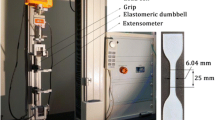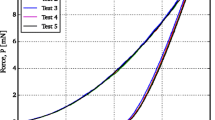Abstract
Indentation tests perpendicular to the major plane of a material have been proposed as a means to index some of its in-plane mechanical properties. We showed the feasibility of such tests in myocardial tissue and established its theoretical basis with a formulation of small indentation superimposed on a finitely stretched half-space of isotropic materials. The purpose of this study is to better understand the mechanics of indentation with respect to the relative effects of indenter size, indentation depth, and specimen size, as well as the effects of material properties. Accordingly, we performed indentation tests on slabs of silicone rubber fabricated with both isotropic, as well as transversely isotropic, material symmetry. We performed indentation tests in different thickness specimens with varying sizes of indenters, amounts of indentation, and amounts of in-plane stretch. We used finite-element method simulations to supplement the experimental data. The combined experimental and modeling data provide the following useful guidelines for future indentation tests in finite-size specimens: (i) to avoid artifacts from boundary effects, the in-plane specimen dimensions should be at least 15 times the indenter size; (ii) to avoid nonlinearities associated with finite-thickness effects, the thickness-to-radius ratio should be >10 and thickness to indentation depth ratio should be >5; and (iii) we also showed that combined indentation and inplane stretch could distinguish the stiffer direction of a, transversely isotropic material.
Similar content being viewed by others
References
Alblas, J. B., and M. Kuipers. Contact problems of a rectangular block on an elastic layer of finite thickness. Part I. The thin layer.Acta Mech. 8:133–145, 1969.
Alblas, J. B., and M. Kuipers. Contact problems of a rectangular block on an elastic layer of finite thickness. Part II. The thick layer.Acta Mech. 9:1–12, 1970.
Alblas, J. B., and M. Kuipers. On the two dimensional problem of a cylindrical stamp pressed into a thin elastic layer.Acta Mech. 9:292–311, 1970.
Batra R. C. Quasistatic indentation of a rubberlike layer by a rigid cylinder. Proceedings of the International Conference on Finite Elements in Computational Mechanics, 1985, pp. 345–357.
Beatty, M. F., and S. A. Usmani. On the indentation of a highly elastic half-space.Q. J. Mech. Appl. Math. 28:47–62, 1975.
Bhattacharya A. K., and W. D. Nix. Finite element simulation of indentation experiments.Int. J. Solids Struct. 24:881–891, 1988.
Burnham, N. A., and R. J. Colton. Measuring the nanomechanical properties and surface forces of materials using an atomic force microscope.J. Vac. Sci. Technol. 7:2906–2913, 1989.
Chew, P. H., J. D. Humphrey, and F. C. P. Yin. Regional finite deformations of the in situ canine pericardium.Am. J. Physiol. 264:H97-H103, 1993.
Downs, J., H. R. Halperin, J. Humphrey, and F. C. P. Yin. An improved video-based computer tracking system for soft biomaterials testing.IEEE Trans. Biomed. Eng. 37:903–907, 1990.
Halperin, H. R., P. H. Chew, M. L. Weisfeldt, K. Sagawa, J. D. Humphrey, and F. C. P. Yin. Transverse stiffness: a method for estimation of myocardial wall stress.Circ. Res. 61:695–703, 1987.
Hertz, H.. Über den kontakt elastischer korper.J. Reine Angew Mathematik 92:156–188, 1881.
Humphrey, J. D., H. R. Halperin, and F. C. P. Yin. Small indentation superimposed on a finite equibiaxial stretch: implications for cardiac mechanics.J. Appl. Mech. 59:1108–1111, 1991.
Humphrey, J. D., R. K. Strumpf, and F. C. P. Yin. Determination of a constitutive relation for passive myocardium. I. A new functional form.J. Biomech. Eng. 112:333–339, 1990.
Humphrey, J. D., R. K. Strumpf, and F. C. P. Yin. Determination of a constitutive relation for passive myocardium. II. Parameter estimation.J. Biomech. Eng. 112:340–346, 1990.
Karduna, A. Transverse Stiffness and Constitutive Law for Elastomers and Fiber-Reinforced Elastomers. Baltimore: Johns Hopkins University, M.S. Dissertation, 1989.
Lanir, Y., S. Sikstein, A. Hartzshtark, and V. Manny.In-vivo indentation of human skin.J. Biomech. Eng. 112:63–69, 1990.
Matsuura T., and J. Mansour. Indentation testing of rabbit distal femoral cartilage.ASME Biomech. Symp. 120:157–160, 1991.
Radmacher, M., M. Fritz, and P. K. Hansma. Imaging soft samples with the atomic force microscope: gelatin in water and propanol.Biophys. J. 69:264–270, 1995.
Resar, J. R., J. Z. Livingston, and F. C. P. Yin. In-plane myocardial wall stress is not the primary determinant of coronary systolic flow impediment.Circ. Res. 70:583–592, 1992.
Rivlin, R. S., and D. W. Saunders. Large elastic deformations of isotropic materials. VII. Experiments on the deformation of rubber.Philos. Trans. 243:251–288, 1951.
Shroff, S. G., D. R. Saner, and R. Lal. Dynamic micromechanical properties of cultured rat atrial myocytes measured by atomic force microscopy.Am. J. Physiol. 269:C286-C292, 1995.
Tao, N. J., S. M. Lindsay, and S. Lees. Measuring the microelastic properties of biological material.Biophys. J. 63: 1165–1169, 1992.
Zahalak, G. I., W. B. McConnaughey, and E. L. Elson. Determination of cellular mechanical properties by cell poking, with an application to leukocytes.J. Biomech. Eng. 112: 283–294, 1990.
Author information
Authors and Affiliations
Rights and permissions
About this article
Cite this article
Karduna, A.R., Halperin, H.R. & Yin, F.C.P. Experimental and numerical analyses of indentation in finite-sized isotropic and anisotropic rubber-like materials. Ann Biomed Eng 25, 1009–1016 (1997). https://doi.org/10.1007/BF02684136
Received:
Revised:
Accepted:
Issue Date:
DOI: https://doi.org/10.1007/BF02684136




